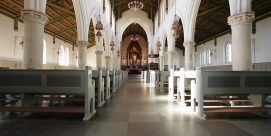Ethics in Designing Prisons
By David Tereshchuk
Imagine you’re an architect. Your assignment? To design a prison.
Heaven knows, you’re needed. The boom in American prison-construction – an almost four-fold growth from 500 to nearly 2000 facilities since the 1970s – has become a (disturbing) wonder of the western world.
You would face challenging ethical questions as a practicing professional. Like … would you, as part of your assignment, be willing to design an execution-chamber? Perhaps not.
Well, that’s maybe not so much of a problem. The building of a brand-new execution-chamber, after all, is a rare event. But let’s pose another, maybe less extreme case. How would you feel about designing solitary confinement units? There’s much greater call for these, since just about every new prison in America calls for some space devoted to “isolation”, “administrative segregation”, “behavior intervention” – or whatever voguish euphemism may be currently in use by whichever prison authority is commissioning the building.
“No! Never!” and “We would never want to design anything that’s related to solitary confinement” were among answers I heard from junior architects and planners in an Oakland, CA architectural practice I recently visited – for the PBS NewsHour Weekend.
Such conscience-led grass-roots members of the profession are being recruited by Raphael Sperry, president of Architects / Designers / Planners for Social Responsibility (ADPSR). He’s campaigning, local chapter by chapter of the national American Institute of Architects, for an overhaul of the profession’s Code of Ethics – in effect to outlaw work on designing solitary confinement units.
From a moral standpoint, says Sperry: “architects can’t design spaces for solitary confinement – that really shouldn’t be acceptable. It’s no more acceptable than designing a torture chamber, because people in there experience torture”.
Sperry’s campaign is an expression in specifically architectural terms of a gradually rising (and often politically non-partisan) tide of opposition to the use of solitary confinement. There’s already been some reform in certain penal jurisdictions (such as Mississippi and North Dakota), and for certain classes of prisoners like those under 18 (as in New York). But truth to tell, these are so far minor changes to the general national picture.
Indeed there’s evidence that, for all the reforms, the use of Solitary is actually still growing. At the federal level, the Government Accountability Office reports that while the total federal prison population rose by 6% between 2008 and 2013, the proportion of inmates being held in solitary confinement grew by nearly three times as much through the same period – that is, by 17% (in actual numbers of individuals, an increase from 10, 650 to 12, 460).
And the disturbing fact remains that, if we count all forms of incarceration from federal down to state and local level, we find the overall total of Americans living in solitary to be still 80,000 or more (out of an overall incarcerated population of approximately 2.2 million).
Perhaps ironically for today’s reforming architects, ‘isolation’ in American prisons began as a moral reform – an improvement on previously gruesome and overcrowded conditions. In the early nineteenth-century the Philadelphia Society for Alleviating the Miseries of Public Prisons (of which Benjamin Franklin had been an early member) successfully lobbied for the Pennsylvania Legislature to build a prison entirely designed on the principle of solitary confinement.
A British architect, John Haviland, won a hundred dollars for his design, a star-shaped floor-plan comprising blocks of galleried cells radiating outward, with in theory a “panoptic” system of all-seeing observation for jailers watching from a central point. Each of its original 250 cells had its own small exercise-yard. Indeed remarkable measures were taken to ensure no communication at all between prisoners, or between prisoners and guards. On the rare occasion when prisoners might be out of their individual confinement, they would have to wear a hood without eye-holes. Labor was done in the prison – but nothing communal, only the kind of work achievable within an individual cell, such as shoe-making and weaving.
The originally well-meaning, in part Quaker-influenced, theory was that complete isolation would make prisoners reflective … they would regret their crime … and become penitent. Hence the new vocabulary, ushered in with Haviland’s prison being named the Eastern State Penitentiary.
But the experiment was to be judged a failure eventually. After eight decades of determined effort the so-called “Pennsylvania Method” of “separate or solitary confinement at labor” was abandoned. It had in its turn provoked its own protest and reform movement – including notably the novelist Charles Dickens who came to visit from England and condemned it memorably: “I hold this slow and daily tampering with the mysteries of the brain to be immeasurably worse than any torture of the body”.
Such is Eastern State Penitentiary’s major lesson from history (and indeed its buildings are now a Historic Site, in effect a museum of incarceration). But history moved on, and solitary confinement once again gained considerable ground in the latter part of the twentieth century, usually as a form of in-house punishment – or for some prisoners’ protection from the general population. Troublingly, it came to be employed for inordinate lengths of time, even decades in some cases. It’s that surge, and its continuance despite the growing body of psychological research that demonstrates solitary’s harmful psychological effects, that we are still confronted with now.
Raphael Sperry’s efforts to ban solitary confinement from the architect’s work-docket have met institutional resistance. The AIA has so far resisted substantial change to its code of ethics – maintaining that a generalized “standard” expressed in its Code is enough to cover the question of prison work (or “Justice Architecture” as it’s known in the trade):
Members should employ their professional knowledge and skill to design buildings and spaces that will enhance and facilitate human dignity and the health, safety, and welfare of the individual and the public.
And there remains a body of opinion among prison-experienced architects that they can perfectly well continue their work, and meanwhile adhere to ethical principles that are perfectly supportable. They feel this in light of what they see as the practicalities of prison life, and a continuing need for solitary confinement of some kind, and for just some (hopefully, only short) periods of time.
Jim Mueller, a retired architect who’s made plans for federal, state, county and international places of incarceration, worries that if architects are barred from doing this work – prison conditions could worsen.
In his interview with me for the PBS NewsHour he said: “Perhaps by doing it we can effect certain types of change within the criminal justice system … It’s better that we do it than not do it, because I’m worrisome about who would do it in the absence of architects doing it”.
But an undaunted Sperry remains determined to carry his fight to next year’s national convention of the AIA – and he feels a groundswell is rising in his and fellow-activists’ favor:
“The AIA has not come all the way around, but they’ve started to come around. I think it just takes them a while to accept some difficult facts … Once they do that, they’ll know what the right thing to do is”.
David Tereshchuk has reported on ethics and belief for PBS’s Religion and Ethics NewsWeekly and The PBS NewsHour Weekend. He writes the international multimedia commentary TheMediaBeat.US – which also appears at Huffington Post.






